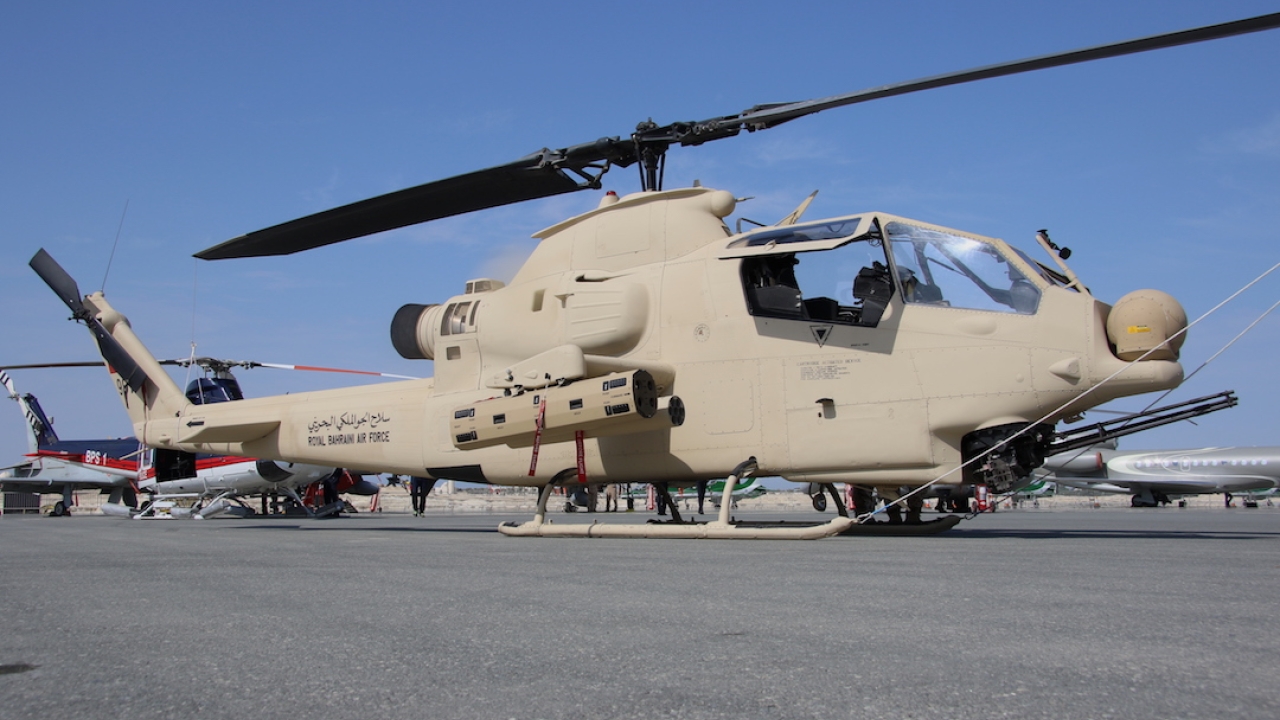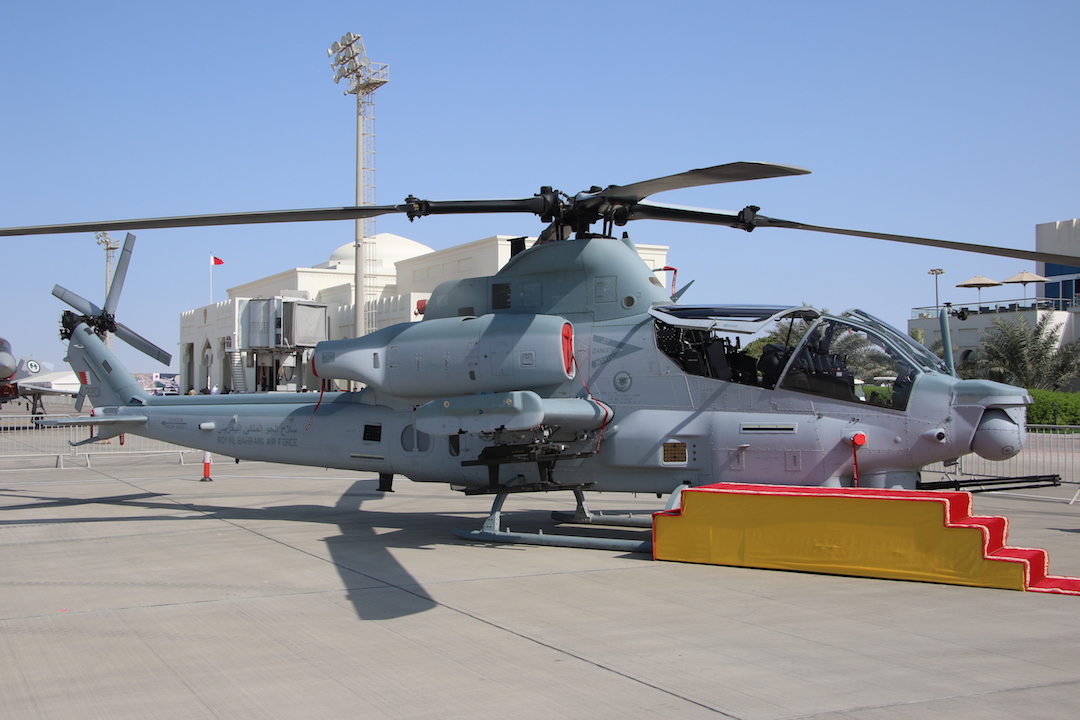Cobras give Bahrain extra bite
Helicopters play a major role in the defence and security of Bahrain. Alan Warnes has been looking at the Royal Bahraini Air Force and the background to its capabilities.

New look: Two upgraded AH-FBs were seen in public for the first time at BIAS 22. Picture: Alan Warnes.
The Royal Bahraini Air Force now has one of the largest AH-1 Cobra attack helicopter fleets in the world.
Comprising 17 upgraded AH-1FB Cobras and 12 AH-1Z Vipers, known locally as ‘Zulus’, that’s an undeniably large number of gunships for such a small island.
However, to understand why, you have to go back to April 1986, when Qatar attacked Bahrain’s Hawar Islands in a bid to take them over.
The RBAF, with its Bell 212s, really came of age back then after the Qatari forces captured a multinational workforce building a coastguard station at Dibal. It was tasked to fly in troops, ammunition and medical supplies to support Bahraini units on the islands.
Operating at night, with no night vision goggles, often at 100ft (30m) over land and sea with no radar or radio for three continuous nights, the helicopters completed 25 missions.
This was to be the biggest ever challenge to the RBAF’s helicopter units and, while the Bell 212 crews of 3 Squadron performed heroically, the government now understood the need to acquire armed helicopters to deter further attacks.
The Hawar operation, as it is known, received little international attention. The Hawar Islands dispute was resolved in 2001 but it taught the Bahraini Government a lesson. With Iran undeniably a big threat to the Middle East’s relative peace, the military doctrine created for Hawar stands resolute against an Iranian offensive.
The RBAF acknowledges that any serious attack is likely to come in overwhelming numbers, and that’s the main reason why its helicopter inventory is heavily influenced by the AH-1 Cobras.
The RBAF acquired its first Cobras in 1994, when 14 ex-US Army AH-1Es and six TAH-1Ps, the latter configured for the training role without any capability to carry cannons or weapons, were acquired. They all equipped No 8 Squadron, established the same year at Riffa Air Base.
A follow-on order for 10 more reconditioned AH-1Es from the US Army followed in 1997. However, some were starting to show their obsolescence and, according to one local source, they were in poor shape and so were rejected.
In 2002, 12 AH-1Fs were delivered, which brought with them full infrared day and night vision equipment (C-NITE), mission-control computers, and a wire-guided missile capability. This led to the standing up of a second AH-1 unit at Riffa, No 9 Squadron.
According to an RBAF officer, all the earlier AH-1Es have now been retired and broken up, with their spare parts being used to keep the AH-1F fleet flying.
By the mid-2010s, it was obvious these attack helicopters did not have the technological edge the RBAF required for future warfare operations. The government scoured the market, looking for a capable helicopter to provide close air support for its ground troops. The new helicopter would not replace the older AH-1Fs but supplement them, and it seemed, in 2015, that the Bahrainis would opt for Turkey’s T129 advanced attack and reconnaissance (ATAK) helicopter.
Turkey’s backing of Qatar, when the GCC sanctioned the tiny desert state in 2017, put paid to those plans.

However, negotiations on an AH-1F upgrade, to ensure there was commonality with the T129, had been signed off already. As part of a multi-million deal, agreed in June 2015, Turkish Aerospace was to upgrade 17 AH-1Fs with avionics systems already operational on Turkey’s gunship helicopter.
The prototype upgraded AH-1FB (B for Bahrain) made its first flight from TAI’s Ankara facility in September 2017 and, after two years with integration work and testing completed, it was airfreighted back to Bahrain.
By the time of the November 2018 Bahrain International Air Show (BIAS), three aircraft had been upgraded, but both TAI and Bahrain were not keen to discuss the work because of the ongoing political row.
Finally, at last year’s 2022 BIAS, two upgraded AH-1FBs made their public debut.
“We have turned an old helicopter into a new one,” said one RBAF officer. “After the first aircraft was delivered here, the RBAF worked alongside Turkish engineers to integrate the upgrades at Riffa Airbase, where the Cobras are based.”
The work includes the integration of an Aselsan ASELFLIR 300T electro optical/infrared turret mounted on top of the Cobra’s nose to replace the laser range finder. The system houses a high resolution infrared camera, laser range finder/designator (LRF/D), laser spot tracker, colour day TV camera and a spotter TV camera.
In the front cockpit, two multi-function displays replace the old analogue gauges, and both cockpits have been upgraded for night
Mounted on the both side of the two Cobras on the outer pylons are a pair of quadrack launchers to accommodate Roketsan Cirit 2.75 inch laser-guided missiles, to complete a wholly Turkish upgrade.
The AH-1FBs with their desert camouflage are used to support troops on the ground.
When it became obvious the RBAF would not be ordering the T129, the force opted to buy the Bell AH-1Z Viper – 12 of them at a cost of $912 million.
The contract announcement came at BIAS in November 2018, when the RBAF commander, Major General Hamad al Khalifa, said: “The world’s most advanced attack helicopter will continue to secure the country. Deliveries will start in the second half of 2022 and be completed in early 2023.”
He continued: “The aircraft will work alongside the current Cobra fleet and help to improve our share of the responsibility in the growth and security of the Gulf region.”
Bell announced, in October 2021, that the first AH-1Z for Bahrain had been completed, with the first pair being handed over to the RBAF in mid-2022. By the end of 2022, six of the 12 had been delivered with the remainder due early this year.
The AH-1Z Viper is designed to meet the operational requirements of the United States Marine Corps (USMC), with a strong focus on a reduced logistical footprint and full marinization.
The aircraft is an improvement of the AH-1W Super Cobra, with an upgraded glass cockpit and a wider capability due to the variety of weaponry.
Speaking at BIAS 2022, Mike Deslatte, Bell H-1 vice president and program director, said: “The AH-1Z brings a lot of benefits, largely due to the number of different missions it can handle – close air support, anti-armour and, in USMC configuration, anti-air, so it’s quite a versatile aircraft.”
The latest generation of the Viper has a Lockheed Martin target sight system, along with avionics that Bell rates as world class, with Deslatte adding: “Employing that type of capability is a game-changer. Having a proven state-of-the-art platform will help contribute to the security of Bahrain, while improving interoperability with US forces.”
The RBAF confirmed that its AH-1Zs do not yet operate with an AIM-9 Sidewinder, or come equipped with the Link 16 datalink system.
Being marinized, the aircraft is protected against the kind of corrosion that the Bahrain climate will bring. “It was fully marinized from the point of manufacture all the way down to detailed level parts,” said Deslatte.
“This provides resistance to the likes of salt, spray, sand and dust, while working in an austere environment. You can encounter all these kind of elements when deploying forward with the units that you support on the ground.”
Stay up to date
Subscribe to the free Times Aerospace newsletter and receive the latest content every week. We'll never share your email address.

